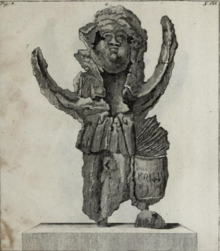Chislobog (Cyrillic: Числобог) is a slavic pseudo-deity of time and/or numbers invented in the 20th century, mentioned in the Book of Veles, spelled as 'ченслобг' ("chenslobg")[2] The book is normally seen as a literary forgery which is claimed to be an ancient Slavic mythical text.[3][4][5] His name supposedly comes from the words number (Cyrillic: число, chislo) and god (Cyrillic: бог, bog).[a]
| Chislobog | |
|---|---|
Time, Numbers | |
 Zislbocg from Prillwitz idols | |
| Other names | Числобог |
| Venerated in | Ynglism[1] |
He is also identified with Zislbocg/Zislbog from Prillwitz idols, an 18th-century archaeological forgery. However, Andreas Gottlieb Masch, who described the idols, wrote that while the previous figurine (in his list) is identified with the Sun, the one beside him must be an image of the Moon, while noticing that he was not familiar with the word.[6]
Despite his dubious origins, he is worshipped prominently in Ynglism,[7] a new religious movement which claims to be reviving ancient slavic religion.[8]
Notes
edit- ^ Due to the nature of the Veles book as a forgery not written in an actual language, these words cannot be said to be in any given language, however they are recognizable to most Slavic speakers
References
edit- ^ Ynglist website (in Russian)
- ^ Кутарев, Олег Владиславович (2017-08-10). "Святыни полабских славян в Германии" (in Russian). Пантеон. Retrieved 2021-04-25.
- ^ Suslov, Mikhail; Kotkina, Irina (2020). "Civilizational discourses in doctoral dissertations in post-Soviet Russia". Russia as Civilization. Routledge. p. 171. doi:10.4324/9781003045977-8. ISBN 9781003045977. S2CID 219456430.
- ^ Oleh, Kotsyuba (2015). "Rules of Disengagement: Author, Audience, and Experimentation in Ukrainian and Russian Literature of the 1970s and 1980s". Harvard University, Graduate School of Arts & Science: 22.
- ^ Andreas Gottlieb Masch, Daniel Woge (illustrations), Die gottesdienstlichen Alterthümer der Obotriten aus dem Tempel zu Rhetra am Tollenzer See, 1771, §§ 125-130
- ^ "Боги наши" [Our gods]. Derzhava Rus. Archived from the original on 26 June 2017.
- ^ https://www.academia.edu/36912098/